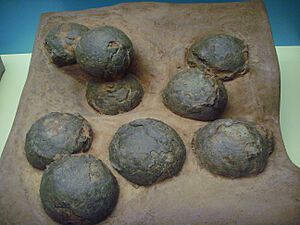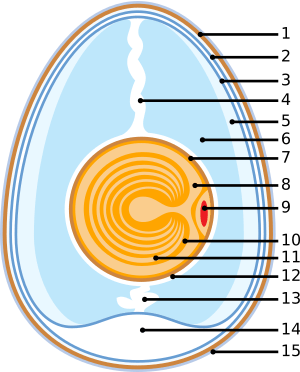Cleidoic egg facts for kids
The cleidoic egg is a special type of egg laid by reptiles and birds. The word "cleidoic" comes from the Greek word kleistos, which means "closed". This name fits perfectly because these eggs are like tiny, closed worlds that protect and feed a growing baby animal.
You might also hear the cleidoic egg called an amniotic egg. This is because it's a key feature of a group of animals called amniotes. This group includes reptiles, birds, and even mammals (though most mammals now give birth to live young instead of laying eggs).


Contents
What Makes These Eggs Special?
Cleidoic eggs have a tough, protective shell. This shell keeps the egg safe and helps it survive outside of water. The shell has tiny holes, so air can get in, but it's strong enough to prevent the egg from drying out. Some shells are flexible, while others are hard and made of calcium carbonate, like the shells of chicken eggs.
Inside the egg, there's all the food and water the baby animal (called an embryo) needs to grow. This means that animals like reptiles and birds don't need a larval stage, like the tadpoles that amphibians (like frogs) have. Instead, the baby develops fully inside the egg until it's ready to hatch.
These eggs also have special membranes inside. These membranes help protect the embryo and manage its waste. They are a key reason why these eggs are so successful on land.
Why Are Cleidoic Eggs Important?
The biggest reason cleidoic eggs are important is that they allowed animals to reproduce away from water. Before these eggs evolved, most animals had to lay their eggs in water, just like fish and amphibians do today. The cleidoic egg was like a "private little pond" for the embryo, providing all the water and nutrients it needed on land.
Scientists believe these eggs first appeared a very long time ago, during the Carboniferous period. This was after the first land animals (called tetrapods) evolved, but before amniotes split into the groups that would become reptiles and mammals. This invention was a huge step in evolution!
How Reproduction Changed
Think about frogs. They lay a huge number of eggs in water and then usually leave them. But with cleidoic eggs, animals could change their behavior. They started to:
- Invest more: Instead of laying many unprotected eggs, they laid fewer, more protected eggs.
- Care for young: Many reptiles and birds, like crocodiles, started to guard their nests and protect their young.
- Internal fertilization: Since eggs were laid on land, the male and female animals had to mate to fertilize the egg inside the female's body before it was laid.
These changes in how animals reproduced also led to other changes. Animals developed more complex brains and learned new behaviors. For example, mammals take care of their young even more. They feed them milk and protect them for a long time. Humans take this even further, with a very long period of learning and social life before young become independent. All these amazing adaptations were made possible by the early evolution of the cleidoic egg.
Live Birth: A Later Step
While most reptiles and birds lay cleidoic eggs, some animals have evolved to give birth to live young. This is called live birth. For example, most mammals give birth to live babies. However, a few mammals, called monotremes (like the platypus), still lay eggs!
Even with live birth, the basic idea of the cleidoic egg is still there. When a mammal embryo grows inside its mother's womb, it's surrounded by the same types of protective membranes that are found inside a bird's egg. Live birth has also evolved independently in some reptiles, like certain snakes and ancient sea reptiles called Ichthyosaurs.
Big Impact on Life on Earth
The cleidoic egg was a truly amazing evolutionary invention. It allowed animals to move into many new habitats on land, leading to a huge burst of new species. This is called an adaptive radiation. Because of this egg, reptiles, birds, and mammals could spread across the planet. In contrast, amphibians, who still need water for reproduction, are limited to fewer, more specialized places today.
Related pages



